<< Previous | Displaying results 5801-5850 of 6769 for "" | Next >>
Haviva Reik before her emigration to Palestine. Banska Bystrica, Czechoslovakia, 1934. Between 1943 and 1945, a group of Jewish men and women from Palestine who had volunteered to join the British army parachuted into German-occupied Europe. Their mission was to organize resistance to the Germans and aid in the rescue of Allied personnel. Reik was one of these parachutists. She parachuted into Slovakia and was captured and killed in November 1944.

Haviva Reik, a parachutist from Palestine, before her mission to aid Jews in Slovakia. She was caught and executed by the Nazis. Palestine, probably before September 1944.
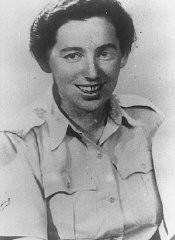
Zvi Ben-Yaakov (left) and Haviva Reik (center), Jewish parachutists under British command. Their mission was to aid the Jews in Czechoslovakia, where they were caught by the Nazis and executed. Palestine, before September 1944.
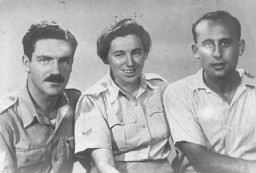
Group of Jewish parachutists under British command including Haviva Reik (center), who was sent into Slovakia. Palestine, wartime.
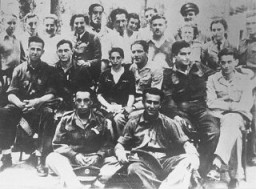
Haviva Reik and other parachutists from Palestine, under British command, sent to Slovakia to aid Jews during the Slovak national uprising. Hayim Hermesh (left), Haviva Reik (second from left), Rafi Reiss (behind Reik), Abba Berdichev (second from the right), and Zvi Ben-Yaakov (right), on the Tri Duby airfield before being sent to Slovakia. Czechoslovakia, September 1944.
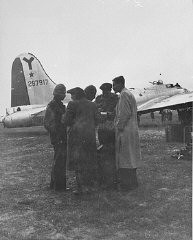
Three Jewish partisans in the Wyszkow Forest near Warsaw. Poland, between 1943–44.
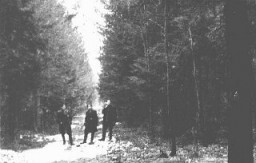
Group portrait of a Jewish partisan unit operating in the Lithuanian forests. Many of its members had been involved in resistance activities in the Kovno ghetto. Lithuania, 1944.
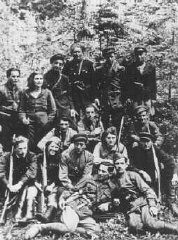
Shortly before liberation by Allied forces, French resistance fighters staged uprisings across occupied France. Here, fighters gather arms during the Marseille uprising. Marseille, France, August 1944.
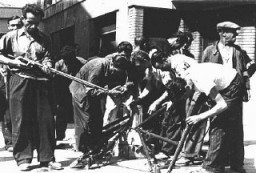
Bedukian Sarkis, a French partisan of Armenian extraction, patrols a street along with another partisan during the August 1944 insurrection in the south of France. Marseille, France, August 1944.
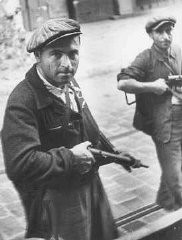
A group of Jewish partisans, members of a unit of the Armée Juive (Jewish Army). France, wartime.
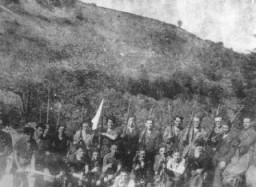
A group of Jewish resisters, members of a fighting organization (Organisation Juive de Combat). Mazamet, France, wartime.
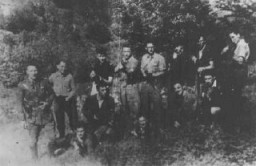
The public hanging of three members of the Communist underground on Karl Marx Street in Minsk. One of the victims wears a large placard around his neck that reads "We are partisans and have shot at German soldiers."This execution was one of four carried out in Minsk on October 26, 1941, by German troops with the 707th Infantry Division. Altogether, 12 members of the Communist underground were publicly hanged in four groups of three near a yeast-making factory. This is believed to be the first public…
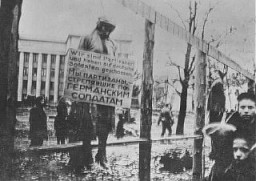
German forces occupied Riga in early July 1941. Here, war damage to Riga's city hall is shown by blackened areas around the building's windows. Riga, Latvia, August 1941.
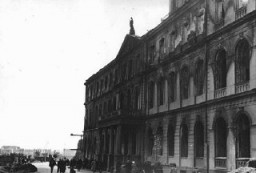
Pierre Laval, head of the government of Vichy France and Nazi collaborator. Shown here delivering a radio address. France, 1941–42.
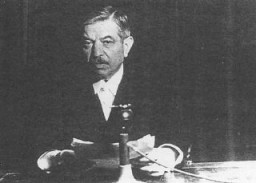
Arrival of Jewish refugees from Germany. The Joint Distribution Committee (JDC) helped Jews leave Germany after the Nazi rise to power. France, 1936.
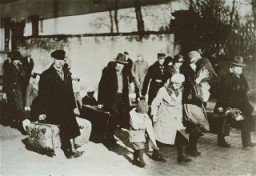
A Jewish passenger prays on board a refugee ship from Germany bound for Argentina in 1938.
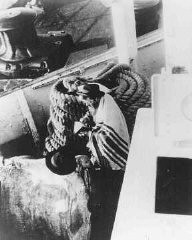
Jewish refugee children look out of the train window as they leave Berlin. They were on a Kindertransport from Germany. Schlesischen train station, Berlin, Germany, November 29-30, 1938.
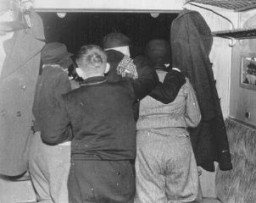
Delegates to the Evian Conference, where the fate of Jewish refugees from Nazi Germany was discussed. US delegate Myron Taylor is third from left. France, July 1938.
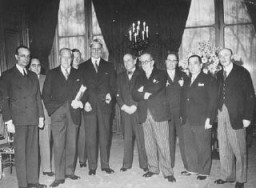
The Hotel Royal, site of the Evian Conference on Jewish refugees from Nazi Germany. Evian-les-Bains, France, July 1938.
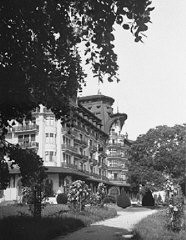
The Evian Conference on Jewish refugees. From left to right are French delegate Henri Berenger, United States delegate Myron Taylor, and British delegate Lord Winterton. France, July 8, 1938.
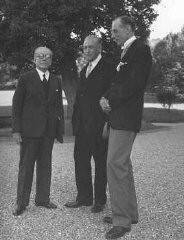
A group of German and Austrian Jewish refugee children arrives in New York on board the SS President Harding. New York, United States, June 3, 1939.
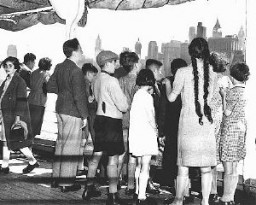
German Jewish refugees look through portholes of the St. Louis, in Havana harbor. Cuba refused to let the passengers disembark. Cuba, May or June, 1939.

Two German Jewish women wearing the compulsory Jewish badge. Germany, September 27, 1941.
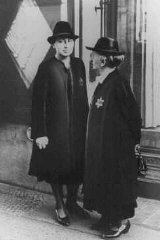
A Jewish couple wearing the mandatory Jewish badge walks along a street in a German city. Germany, September 27, 1941.
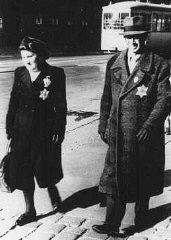
An elderly German Jewish woman wearing the compulsory Jewish badge. Berlin, Germany, September 27, 1941.
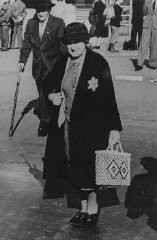
Jewish women deported from Bremen, Germany, are forced to dig a trench at the train station. Minsk, Soviet Union, 1941. (Source record ID: E9 NW 33/IV/2)

A poster in Hebrew soliciting contributions from members of the Yishuv (the Jewish community of Palestine) for army recruitment and for efforts to rescue European Jewry. The Hebrew text reads "Give a hand in rescue, the Fund for Recruitment and Rescue." Palestine, July 22, 1943.
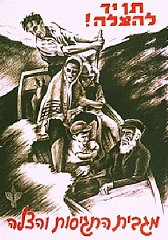
This photograph shows the refugee ship Pentcho, carrying over 500 passengers bound for Palestine, sailing in the Aegean Sea. It had departed from Bratislava on May 18, 1940. In October 1940, while the Pentcho was sailing in Italian territory, its boiler exploded. The passengers and crew were able to get ashore and offload their supplies before the ship finally sank. On October 18 and 19, Italian authorities picked up the refugees and took them to Rhodes. They stayed there for over a year in a…
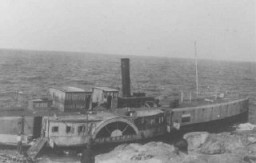
Jewish refugees in Lisbon, including a group of children from internment camps in France, board a ship that will transport them to the United States. Lisbon, Portugal, June 1941.

Jewish refugee youth from French transit camps at the Children's Aid Society (OSE) home "Maison des Pupilles de la Nation." Some of the children are in flight, en route to Switzerland. Aspet, France, June-August 1942.
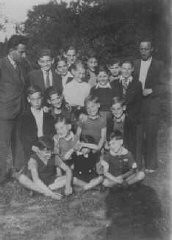
Jewish refugee youth, on an escape route from France to Switzerland, at a Children's Aid Society (OSE) girls' home. Couret, France, ca. 1942.
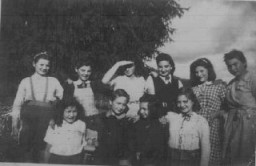
Children and staff leaving for the "Morgenroyt" schools summer camp, organized by the Bund (Jewish Socialist party). The camp was located near Chernovtsy on the Prut River. Chernovtsy, Romania, 1939.

In Hitler's presence, Romanian ruler Ion Antonescu signs the Three-Power Agreement. Berlin, Germany, November 23, 1940.
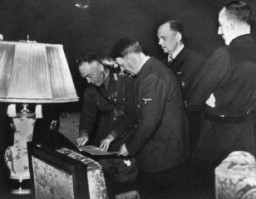
Along the route from Iasi to either Calarasi or Podul IIoaei, Romanians remove corpses from a train carrying Jews deported from Iasi following a pogrom. Romania, late June or early July 1941.

During the deportation of survivors of a pogrom in Iasi to Calarasi or Podul Iloaei, Romanians halt a train to throw off the bodies of those who had died on the way. Romania, July 1941.
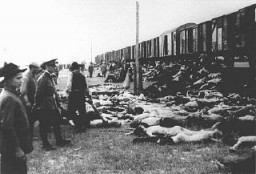
Romanian Jews who were assembled in a Bessarabian village in September 1941 before deportation to Transnistria.
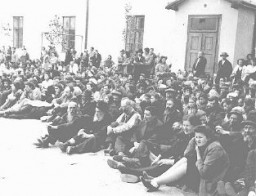
An 18-month-old Jewish boy, Chaim Leib, who was murdered at the Auschwitz killing center in occupied Poland. Bukovina, Romania, 1942.
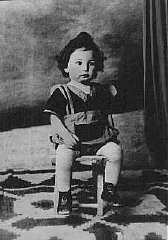
Former Romanian prime minister Ion Antonescu (center) before his execution as a war criminal. Fort Jivava, near Bucharest, Romania, June 1, 1946.

A Romanian firing squad prepares to execute former Romanian prime minister Ion Antonescu. Camp Jivava, near Bucharest, Romania, June 1, 1946.

German soldiers lead blindfolded Polish hostages to an execution site. Olkusz, Poland, July 16, 1940.
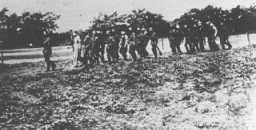
A Nazi decree issued in October 1941, in German and Polish, warns that Jews leaving the ghetto, or Poles who aid them, will be executed. Czestochowa, Poland.
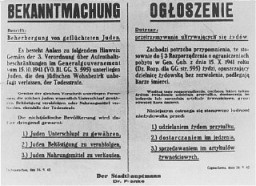
German soldiers expel Polish inhabitants from the Zamosc area. Poland, 1942-1943.
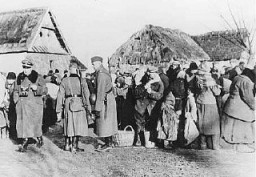
German officers examine Polish children to determine whether they qualify as "Aryan." Poland, wartime.
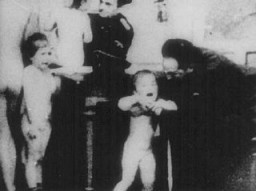
Polish babies, chosen for their "Aryan" features, to be adopted and raised as ethnic Germans. Poland, 1941–1943.
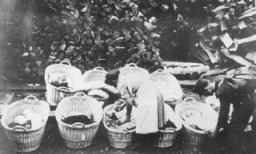
Polish and Russian forced laborers shot by the SS after they had collapsed from exhaustion during a death march. Wisenfeld, Germany, April 26, 1945.

A Polish town in ruins after six years of war and German occupation. Poland, 1945.
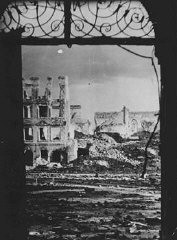
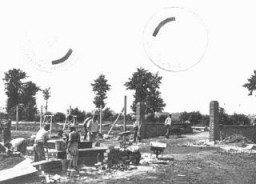
Prisoners at forced labor in the Neuengamme concentration camp, Germany, 1941-1942.
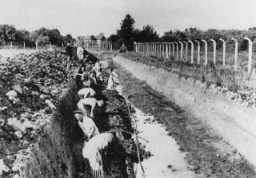
Prisoners at forced labor in the brick factory at Neuengamme concentration camp. Germany, date uncertain.
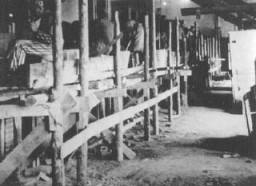
View of the Neuengamme concentration camp. Prisoners stand behind the fence that separates the "protective custody" camp from the manufacturing sectors of the camp. In the distance are the crematorium and the Walther armaments works. Photograph taken between 1940 and 1945, Neuengamme, Germany.
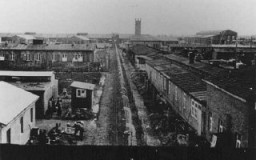
We would like to thank Crown Family Philanthropies, Abe and Ida Cooper Foundation, the Claims Conference, EVZ, and BMF for supporting the ongoing work to create content and resources for the Holocaust Encyclopedia. View the list of donor acknowledgement.